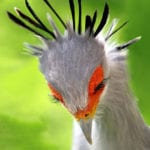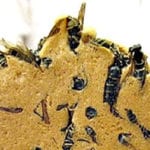 Weird Stuff
Weird Stuff  Weird Stuff
Weird Stuff  Our World
Our World 10 Ways Your Christmas Tree Is More Lit Than You Think
 Movies and TV
Movies and TV The 10 Coolest Stars to Set Sail on The Love Boat
 History
History 10 Things You Didn’t Know About the American National Anthem
 Technology
Technology Top 10 Everyday Tech Buzzwords That Hide a Darker Past
 Humans
Humans 10 Everyday Human Behaviors That Are Actually Survival Instincts
 Animals
Animals 10 Animals That Humiliated and Harmed Historical Leaders
 History
History 10 Most Influential Protests in Modern History
 Creepy
Creepy 10 More Representations of Death from Myth, Legend, and Folktale
 Technology
Technology 10 Scientific Breakthroughs of 2025 That’ll Change Everything
 Weird Stuff
Weird Stuff Ten Bizarre Facts About The Doge Meme
 Our World
Our World 10 Ways Your Christmas Tree Is More Lit Than You Think
 Movies and TV
Movies and TV The 10 Coolest Stars to Set Sail on The Love Boat
Who's Behind Listverse?

Jamie Frater
Head Editor
Jamie founded Listverse due to an insatiable desire to share fascinating, obscure, and bizarre facts. He has been a guest speaker on numerous national radio and television stations and is a five time published author.
More About Us History
History 10 Things You Didn’t Know About the American National Anthem
 Technology
Technology Top 10 Everyday Tech Buzzwords That Hide a Darker Past
 Humans
Humans 10 Everyday Human Behaviors That Are Actually Survival Instincts
 Animals
Animals 10 Animals That Humiliated and Harmed Historical Leaders
 History
History 10 Most Influential Protests in Modern History
 Creepy
Creepy 10 More Representations of Death from Myth, Legend, and Folktale
 Technology
Technology 10 Scientific Breakthroughs of 2025 That’ll Change Everything
10 Animals That Use Biomimicry to Outsmart Predators
In the animal kingdom, mimicry is a remarkable survival strategy numerous species use. It involves animals imitating the appearance or behavior of other species or objects in their environment. This deceptive tactic is an evolutionary adaptation, allowing them to fool predators and catch prey.
Mimicry plays an important role in shaping survival dynamics, blurring the lines between reality and illusion. Today, we’re exploring animals that rely on this defense mechanism to gain an edge in the predator-prey arms race. Join us on a journey that unveils nature’s ingenuity and the perpetual quest for survival. Check out these ten animals that use mimicry as a defense mechanism.
Related: 10 Strange Ways Insects Have Evolved To Survive
10 Alligator Snapping Turtle
First up has to be the very sneaky alligator snapping turtle. This turtle is a master of deception when it comes to snagging a tasty meal. It has a tongue that just so happens to resemble a delectable worm, the ultimate temptation for unsuspecting prey. The turtle waits, pretending to be a worm until an unfortunate fish takes the bait and *snap* becomes dinner!
Now, the concept is called aggressive mimicry. It’s like the turtle’s secret superpower. By mimicking harmless models, it cleverly avoids being correctly identified by its prey. Talk about a master of disguise!
And guess what? This mimicry thing really works in favor of the alligator snapping turtle’s survival. With its deceptive tongue, it effortlessly attracts prey and feasts like a true champion. No need to chase around endlessly for food when you can just sit back, lure unsuspecting victims, and enjoy an easy meal—like underwater DoorDash.
9 Tree Ocelot
Also known as the margay, the tree ocelot has one mischievous mimicry tactic! This feline knows how to put on a show to attract its next meal. It can actually imitate the sound of a cute little baby monkey. How genius is that?
In Brazil, researchers from the Wildlife Conservation Society and UFAM had a front-row seat to witness this spectacle. The tree ocelot decided to channel its inner monkey and started squealing like a little primate in distress. This is also aggressive mimicry, or as we like to say, imitation at its finest. The tree ocelot hoped the adult monkeys would fall right into its clutches, unaware of the danger lurking behind the adorable facade. But, this time, the plan didn’t quite pan out. Those quick-thinking pied tamarin monkeys weren’t fooled for long. They sounded the alarm, warning their pals to flee, and left the tree ocelot with nothing but an empty stomach.
Well, you win some, you lose some, right? Although the cunning ocelot didn’t score a tasty meal this time, we have to give it credit for trying. It’s all part of the wild game of survival, where animals pull out their bag of tricks and hope for the best.
8 Bumblebee Moth
The bumblebee moth, also known as the snowberry clearwing or Hemaris diffinis, perfected the art of fooling predators and avoiding becoming someone’s lunch—all by getting a little buzzed!
The bumblebee moth sports a stunning resemblance to an actual bee. With its furry, yellowish body and a bold black band, it’s got that unmistakable bumblebee flair. Bumblebee moths are approximately 1.5 to 2 inches (3.8 to 5 cm) in length, which is roughly the length of a thumb or a little shorter.
But here’s the kicker: the bumblebee moth isn’t harmful at all. It’s what we call a Batesian mimic, a master of imitating the warning signals of harmful species to avoid being devoured. Sneaky, huh?
Now, let’s talk about those wings. The bumblebee moth’s wings have these fantastic clear patches in the middle. These transparent patches are a shared trait among all clearwing moths, including our clever snowberry clearwing. The bumblebee moth also hovers in front of flowers, just like a hummingbird. It even backs up. This clever behavior helps it avoid becoming someone’s main course.
7 Amazonian Antbirds
Amazonian antbirds have harnessed the power of mimicry as a defense mechanism to evade the clutches of predators. How do they do it, you ask? Well, they’ve got a trick up their feathers—mimicking the calls of antshrikes, those aggressive and territorial birds.
These antbirds may not be harmful themselves, but by mimicking the calls of those antshrikes, they effectively keep predators at bay. After all, who wants to mess with an aggressive antshrike?
But the mimicry doesn’t stop there. These crafty antbirds have a knack for mimicking other species within their mixed flocks. Picture a group of insectivorous birds led by a “leader” species. The leader, usually a larger bird with superior predator-detection skills, takes charge of alerting the flock to potential threats. And the other birds in the flock follow suit, mimicking the calls of the leader species to create a united front against predators.
Why do birds form these mixed-species flocks in the first place? Well, there are a few possible explanations. Cooperation is key here—they team up to gain access to more food and share vital information about food sources. It’s a cooperative endeavor where birds in the flock are more likely to spot potential food sources, avoid already exploited areas, and exchange information about where the next meal can be found. It’s a tight-knit community based on similarities in body size, taxonomy, and foraging style.
6 Lyrebird
Lyrebirds imitate the calls of birds of prey to deter predators, tricking them into believing danger is nearby and keeping them at a distance. Male lyrebirds mimic multispecies flocks during courtship, creating the illusion of a predator-filled scene. This clever tactic prevents females from breaking off courtship or leaving before mating, increasing the male’s chances of successful copulation. Female lyrebirds respond by remaining silent, listening to the male’s complex vocal displays.
These birds are renowned for their ability to mimic the songs of other bird species, showcasing their vocal dexterity during mating sessions. Lyrebirds can even mimic human sounds like car alarms, chainsaws, and camera shutters. They’re quite the performers in zoos and wildlife parks!
Lyrebirds also blend seamlessly into their surroundings by mimicking sounds like running water or wind blowing through trees, enhancing their stealth and avoiding detection by predators. Female lyrebirds also produce their own sophisticated vocalizations, incorporating both lyrebird-specific vocalizations and imitations of sounds within their environment. These vocalizations serve various purposes, from nest defense to mediating female-female competition for breeding territories.
5 Fangblenny
The fangblenny’s game plan is simple yet effective. By imitating the appearance and behavior of cleaner fish, which are known for their parasite-removing skills, the fangblenny can stealthily approach other fish without raising any suspicions. Once within striking distance, it launches a surprise attack on its unsuspecting prey.
A study in Behavioral Ecology revealed that fangblennies display risk-taking behavior when faced with potential predators. This indicates that their mimicry is a pretty formidable defense mechanism. The Fangblenny boasts a range of eye-catching colors, including blue with a striking black stripe from snout to tail or orange with two narrow blue lines along its body.
This fish also possesses a unique adaptation for biting and escaping without leaving a trace. Its venom contains morphine-like opioids that numb pain and lower blood pressure, ensuring a painless bite and a swift getaway without attracting attention. But unlike most blennies, the fangblenny is a nimble free-swimmer. This mobility enables it to move stealthily and approach other fish unnoticed.
What truly sets the fangblenny apart is its remarkable ability to switch on its mimic coloration at will. The Fangblenny’s incredible color-changing act is made possible by physiological changes in its skin cells. These cells contain pigments that can expand or contract, allowing the fangblenny to alter its appearance at a moment’s notice.
4 Hognose Snake
To the untrained eye, the hognose snake’s patterns closely resemble that of rattlesnakes. Like a skilled actor, the hognose snake can mimic a cobra through an impressive bluff. It hoods and spreads its neck. This mimicry helps the hognose snake deter predators by making itself appear far more dangerous.
By contorting its neck, the snake further enhances its deceptive appearance, dissuading predators from considering it an easy target. And when faced with a potential threat, the Hognose snake resorts to hissing as a form of bluff. This audial display, combined with its physical mimicry, adds another layer of defense by conveying a message of danger.
And when confronted with danger, the hognose snake can flatten its body. This transformation creates the illusion of a wider and larger snake, intimidating potential predators.
3 Spicebush Swallowtail
The spicebush swallowtail mimics the pipevine swallowtail, a butterfly species toxic to predators. Throughout its life, the caterpillar mimics the appearance of bird droppings or a snake head, blending into its surroundings and looking unappetizing.
In addition to mimicry, the spicebush swallowtail also has club-shaped extensions that come from their back wings. When faced with an attack, these extensions deter predators, too.
As the spicebush swallowtail grows, it undergoes two stages of mimicry. The first is the larval stage, where the larvae have a dark brown coloration, looking remarkably like bird droppings. This clever disguise discourages predators from viewing them as edible. As the larvae reach their final instar and prepare for pupation, they transition to a bright green hue with two prominent black dots and a white highlight.
Once the spicebush swallowtail reaches adulthood, it mirrors the pipevine swallowtail’s coloration, showcasing a distinct green-blue shade in males and a vibrant blue hue in females. Their hindwings feature a half-moon-shaped splotch, while cream-colored oval spots decorate the forewing. Some middle spots can take on a light blue, moon-like form.
2 Mimic Octopus
When it comes to defense, this crafty cephalopod knows how to play mind games. The mimic octopus morphs into a charming crab to seduce unsuspecting prey—only to devour its poor, deluded admirer.
Talk about catfishing!
The mimic octopus carefully selects its disguise based on the situation and the creatures it wants to fool. The octopus can imitate all sorts of toxic and venomous critters to send predators running for the hills. From flounders and snakes to tunicates and sponges, this octopus knows how to rock the imitation game. It impersonates animals with appearance and behavior to become the life of the underwater party:
The mimic octopus does its best impression of the banded sole by flattening out, dragging its legs behind, and slithering. Or the mimic octopus can get cozy in the sand or a snug hole while strategically sticking two arms out in opposite directions. It sports those fashionable black and white bands, all while imitating the slithering moves of the banded sea snake. And it spreads its arms wide and elegantly swims like a lionfish.
1 Orchid Mantis
The orchid mantis knows how to play hide-and-seek with its prey through a technique called crypsis, or Peckhamian mimicry. It blends seamlessly into its surroundings, becoming one with the flora, and cunningly avoids detection by its unsuspecting prey. By mimicking an orchid flower, it beckons bees and butterflies, thinking it’s the perfect spot for a sip of nectar. Little do they know, they’ve walked right into the orchid mantis’s dining hall.
Bon appétit, my floral friend!
Once the prey is within reach, the orchid mantis unleashes its powerful forelegs to snatch its unsuspecting victims. This insect has evolved to resemble an actual orchid flower, with its body resembling delicate petals. It knows how to work those pink or white hues, blending effortlessly with the real flowers it imitates. And its slender body mimics the flower’s stem. But behavior plays a vital role too! The orchid mantis sways gently in the breeze, mimicking the movement of a real flower.








